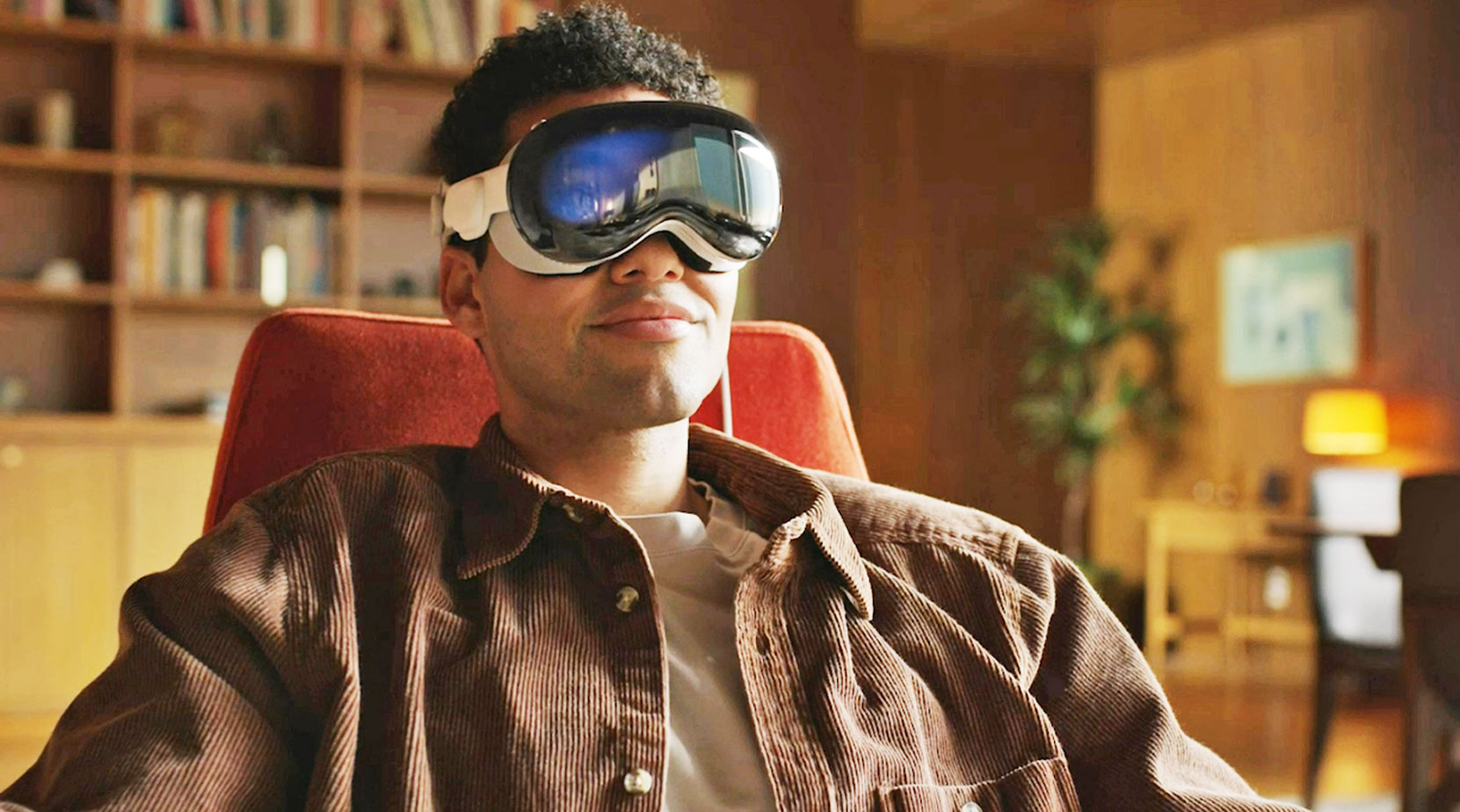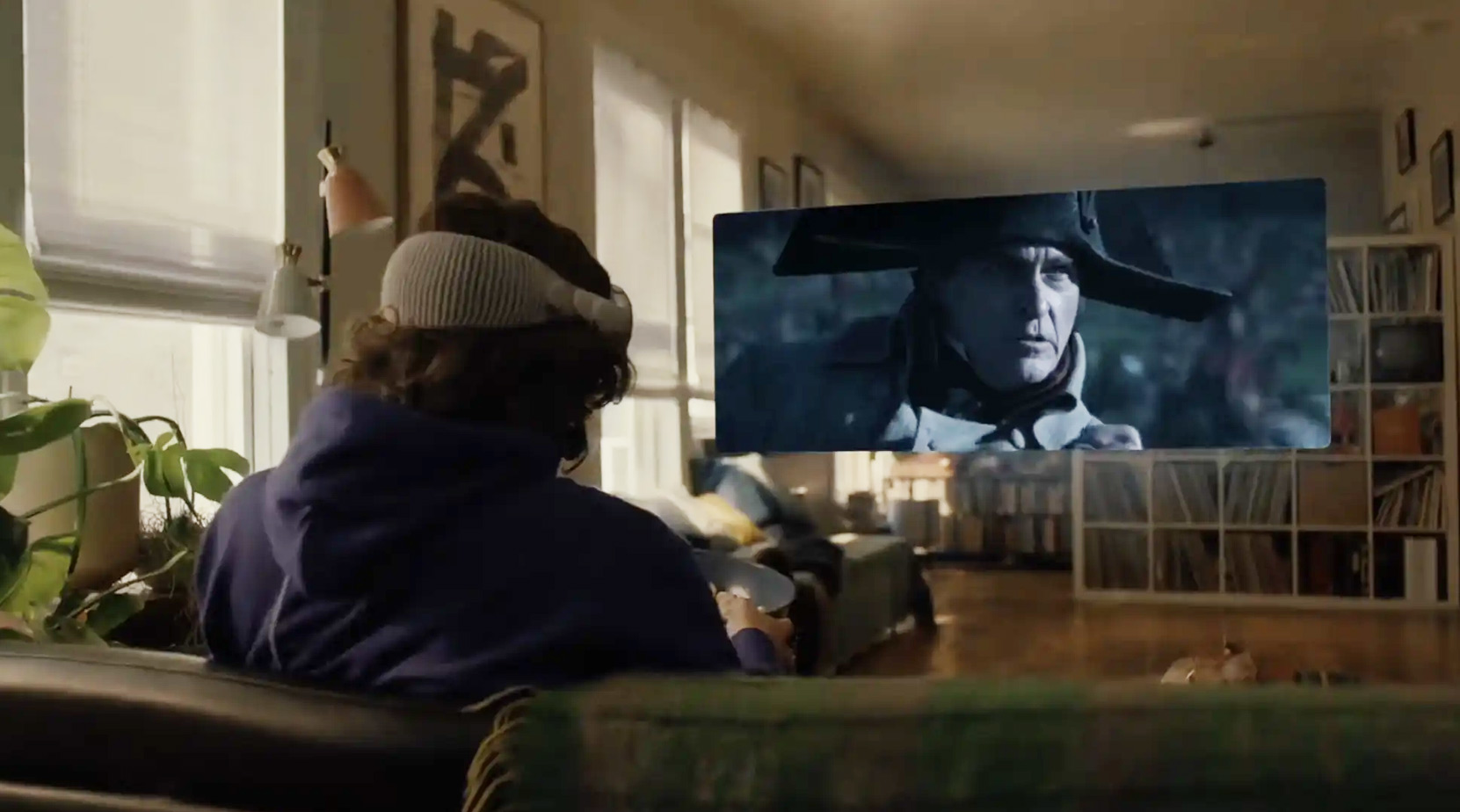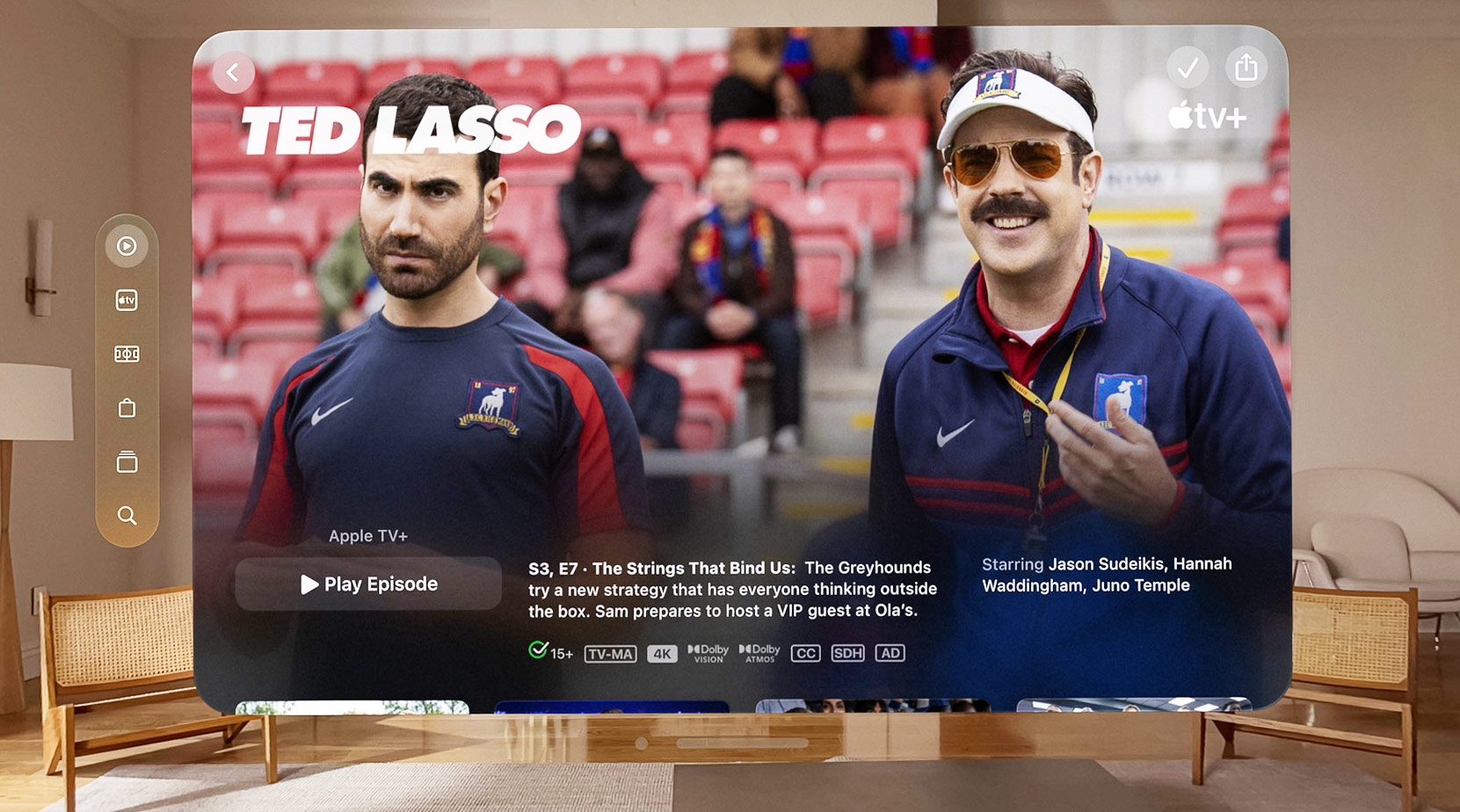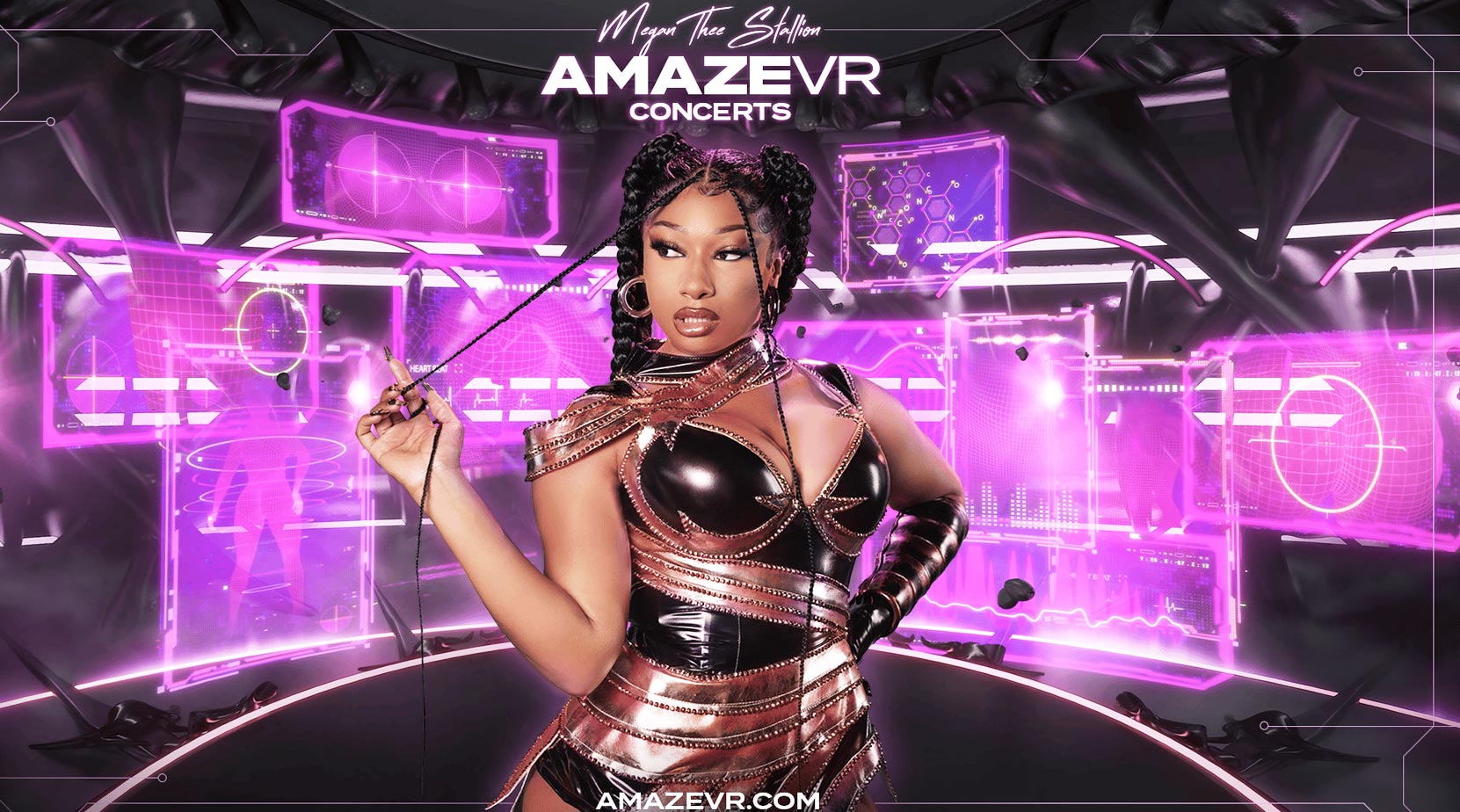What does Apple’s Vision Pro headset mean for the future of movies and TV?

Apple has high hopes for their new Vision Pro headset, but could its “mixed reality” tech really change the game when it comes to streaming stuff from home? Our resident VR guru Luke Buckmaster weighs in.
This week Apple confirmed rumours that’ve been swimming around the virtual and augmented reality industries for eons, announcing at its big annual shindig the Vision Pro—the company’s first major new product in almost a decade. Chief executive Tim Cook prefaced a slick corporate video by declaring the device a “revolutionary new product” that, with its ability to blend digital content with the real world, “can unlock experiences like nothing we’ve ever seen.” The ensuing presentation made it clear that the Vision Pro is being marketed primarily as a device that replaces physical screens with virtual ones, integrating your laptop, smartphone and TV displays into spaces around you.
Like any carefully phrased declaration, words that weren’t used are just as important as those that were. The tech giant’s presentation never included the phrase “virtual reality” despite the Vision Pro being a (very powerful) VR headset. They didn’t mention these words for three primary reasons. One: there’s stigma around VR, including a belief that it’s primarily a medium for gamers. Two: Apple has developed no VR content to accompany its release, making it virtually (ho ho) impossible to sell on these terms. And three: it’s presenting the Vision Pro as a spatial computing device that, as mentioned, is more about new ways to display pre-existing content, plus a sprig of innovative features here and there.
Cook and co didn’t exactly deliver the sexiest sell, explaining that key features include being able to “place apps exactly where you want them” and claiming Vision Pro is great for “writing a long email or working on a spreadsheet in numbers.” At this point, if you’re anything like me, you’re thinking: OK, but where’s the cool stuff? The Stormtroopers marching into your lounge room, the sword fights with ogres, the fantastical, hitherto unimaginable worlds?
I thought things might get sexier when focus turned to watching movies and TV shows. Instead we were informed of the ability to “turn any room into your own personal movie theatre,” which is another way of reiterating that the device inserts flat virtual displays.

Source: Apple
Is watching movies on headsets any good?
There was also a spiel about 3D movies on the Vision Pro having “incredible depth and crisp motion,”” which is weird—because it ignores the fact that Hollywood hardly ever produces 3D movies anymore. I’ve watched several movies in VR, by the way, including 3D movies, a Nicolas Cage flick in the extravagant (and now defunct) three-screen “Barco Escape” format, and several others using the popular app Bigscreen VR, which replicates a communal cinema experience.
These experiences were pretty good but hampered by various limitations. Headsets are quite heavy (including the Vision Pro), have limited battery life (ditto), take longer to boot up than your TV, and are awkward when it comes to handling a drink or snacks. Not to mention if somebody sits next to you and wants to watch too.
So, what does Apple’s Vision Pro mean for the future of movies and TV shows? Not much in the short term. A more exciting question is what entertainment content on the device will look like if and when developers exploit the technology’s incredible potential for spatial and volumetric experiences. This is something I’m passionate about, having completed a PHD on VR as a medium for expressive art and having experienced many amazing VR and AR productions. They’re varied in themes and style but have one thing in common: none involved long periods of looking at two-dimensional screens.

Source: Apple
The best thing about VR and AR headsets
The greatest feature of these technologies, in fact, is revolutionizing the very concept of the screen and destroying what Peter Greenaway memorably described as “the tyranny of the frame.” With content freed from a sectioned-off area of representation, which has been standard for a very long time (in paintings before cinema), imaginative universes can spill over into physical world space. From this perspective the most exciting part of Apple’s presentation was a Disney-produced promo video spruiking their collaboration with Apple.
One moment depicts a plethora of screens broadcasting gridiron, with one player emerging from them to appear lifesize in a lounge room. That’s more like it! Another represents a diorama-like presentation of an NBA game, the court and players appearing in miniature on a coffee table, like a board game. Yes! We also see Mickey Mouse leaping out of a picture on the wall, freeing himself from the aforementioned tyranny and happily bouncing about on an armchair. Nice!
How much of this actually eventuates remains to be seen. But even if these initiatives do come to fruition, they won’t be revolutionary. The gridiron player and Mickey Mouse moment reminded me of the mixed reality experience The World Beyond (which has an alien walking into your home and playing with you) and the Megan Thee Stallion VR Concert (which brings you into close proximity with Thee Stallion, rapping and jiggling her butt right in front of you). The NBA game display is reminiscent of tonnes of AR and VR creations including Puzzling Places (which involves players piecing together volumetric 3D puzzles) and Demeo (a tabletop RPG), to name just a couple. When Apple dropped the word “revolutionary” in the Vision Pro launch video, what they really meant was “presented better than ever.”

Source: AmazeVR.com
Apple and Meta will duke it out
This alone is enough to stir excitement in a mixed reality enthusiast like me. Not necessarily for this device in particular (priced at an eye-watering US$3499) but because it’ll establish new standards and push the industry forward. The future of spatial computing remains uncertain, but this much is clear: the world’s largest tech company has entered the fray, taking on the likes of Meta—currently the biggest player in the VR/AR space. These companies reflect starkly different philosophical approaches. Mark Zuckerberg espouses a Ready Player One-esque belief in VR as a transportive medium, capable of taking us to dizzying new worlds and places, rebuilding reality from the ground up. Cook and co are keen to keep us rooted in the physical world, augmenting our known reality with digital experiences.
As competion heats up, Zuckerberg’s approach will increasingly bend towards Cook’s—and vice versa. In terms of entertainment products on Vision Pro, I predict it won’t take long for developers and in fact the entire userbase to realise that the content that makes this technology sing, that really generates wow factor, will be the kind that breaks the tyranny of flat screens rather than repurposes them. Arthur C. Clarke once said: “virtual reality won’t merely replace television TV, it will eat it alive.” If (or when) he’s right, the 3D movies and spreadsheet displays spruiked by Apple will seem laughably primitive.


















